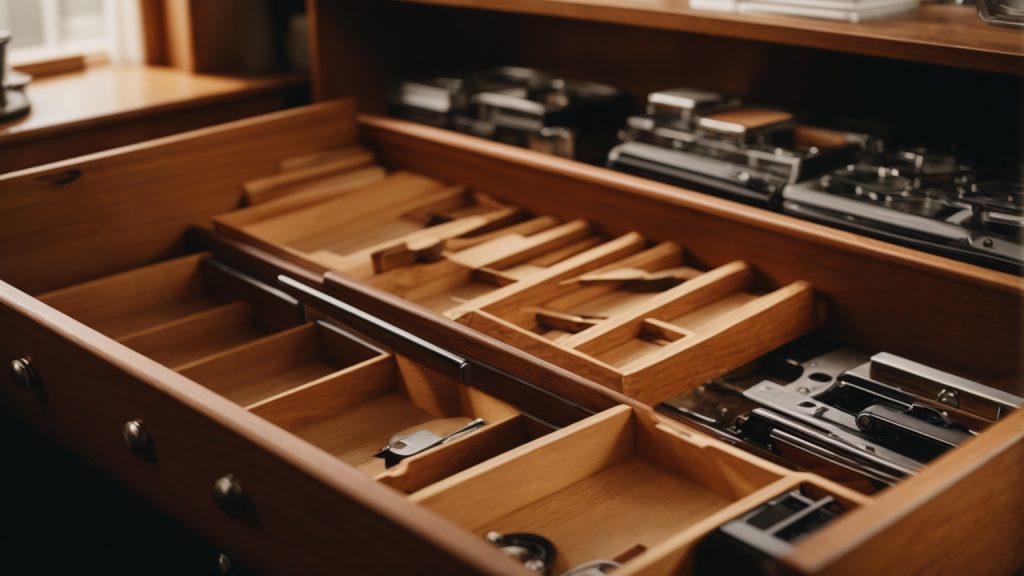Are you struggling with a jammed wooden drawer? It can be frustrating to have a drawer that won’t open or close properly, especially if it’s a drawer you use frequently. Fortunately, there are several simple solutions you can try to get your drawer unstuck and working smoothly again.
One common cause of a jammed wooden drawer is a lack of lubrication. Over time, the wood can dry out and cause the drawer to stick. Applying a lubricant such as paraffin wax or dry spray lubricant can help loosen the drawer and make it easier to open and close. Another cause of a stuck drawer may be misaligned tracks or damaged hardware. In this case, you may need to adjust or replace the tracks or hardware to get the drawer functioning properly again.
By following a few simple steps, you can get your jammed wooden drawer back on track. In this article, we’ll explore some of the most effective methods for fixing a stuck drawer, so you can get back to using your furniture without any frustration. Whether you’re dealing with a minor issue or a more serious problem, we’ve got you covered with practical tips and tricks to help you get the job done.
Understanding the Problem

When you have a jammed wooden drawer, it can be frustrating and time-consuming to try to open it. However, understanding the problem and its causes can help you fix it quickly and easily. In this section, we’ll discuss how to identify the type of jam and determine the cause of the jam.
Identifying the Type of Jam
The first step in fixing a jammed wooden drawer is to identify the type of jam. There are two main types of jams: side-to-side jams and front-to-back jams.
Side-to-side jams occur when the drawer is stuck and won’t move from side to side. This type of jam is often caused by a misaligned drawer slide or a buildup of debris on the slide.
Front-to-back jams occur when the drawer is stuck and won’t move in and out of the cabinet. This type of jam is often caused by a misaligned drawer guide or a buildup of debris on the guide.
Determining the Cause of the Jam
Once you’ve identified the type of jam, the next step is to determine the cause of the jam. There are several possible causes for a jammed wooden drawer, including:
- Humidity: Wooden drawers can expand and contract with changes in humidity, which can cause them to become stuck.
- Loose or worn parts: Loose or worn drawer slides, guides, or rollers can cause the drawer to become misaligned and stuck.
- Debris: Buildup of debris on the drawer slides, guides, or rollers can prevent the drawer from moving smoothly.
- Warped wood: Warped wood can cause the drawer to become misaligned and stuck.
By identifying the cause of the jam, you can take the necessary steps to fix it and prevent it from happening in the future. In the next section, we’ll discuss how to fix each type of jam and its causes.
Basic Techniques to Open Jammed Drawers
If you’re dealing with a jammed wooden drawer, don’t panic. There are a few basic techniques you can try to open it up without causing any damage. Here are three methods to try:
The ‘Tap and Pull’ Method
This is a simple, yet effective way to coax a jammed drawer open. First, try tapping the drawer on the sides with your hand to loosen it up. Then, pull the drawer out slowly and steadily. If the drawer is still stuck, try wiggling it gently from side to side as you pull.
The ‘Wiggle’ Method
If tapping and pulling doesn’t work, try wiggling the drawer from side to side to loosen it up. Hold onto the drawer with both hands and gently wiggle it back and forth. As you wiggle, try pulling the drawer out slowly and steadily. If the drawer still won’t budge, try pushing it back in slightly and then pulling it out again.
Using Lubrication
Another way to free up a jammed wooden drawer is to use a lubricant. Rub paraffin wax on the parts of the drawer where the wood meets. You can find paraffin wax at most hobby and craft stores, or in the canning supplies section of your local grocery store. In a pinch, you can also use candles, bar soap, or even dry spray lubricant.
If the drawer is still stuck after trying these methods, it may be time to call in a professional. Don’t force the drawer open, as this can cause damage to the wood and the tracks. With a little patience and persistence, you should be able to open up that stubborn drawer and get back to using your furniture as normal.
Advanced Techniques to Open Jammed Drawers

If you’ve tried the basic techniques to open a jammed wooden drawer and they didn’t work, don’t worry. There are still a few advanced techniques you can try to get that drawer open. In this section, we’ll cover two advanced techniques: using tools and dismantling the drawer.
Using Tools
Sometimes, all you need is a little extra force to get a stubborn drawer open. Here are some tools you can use:
- Pry bar: A pry bar can help you gently pry the drawer open without damaging the wood or the drawer slides.
- Rubber mallet: A rubber mallet can help you gently tap the sides of the drawer to loosen it from the frame.
- Screwdriver: A screwdriver can help you remove any screws that may be holding the drawer in place.
When using tools, be careful not to damage the wood or the drawer slides. Use gentle force and stop if you feel resistance.
Dismantling the Drawer
If all else fails, you may need to dismantle the drawer to get it open. Here’s how:
- Remove the drawer from the frame: If the drawer is stuck closed, you may need to remove it from the frame to work on it. Check for any screws or nails holding the drawer in place and remove them.
- Remove the drawer face: If the drawer is still stuck closed, you may need to remove the drawer face to access the inside of the drawer. Check for any screws or nails holding the face in place and remove them.
- Inspect the drawer slides: Once you have access to the inside of the drawer, inspect the drawer slides for any damage or debris. Clean the slides with a soft cloth and lubricate them with wax or a dry spray lubricant.
- Reassemble the drawer: Once you have cleaned and lubricated the drawer slides, reassemble the drawer and try opening it again.
Remember, dismantling the drawer should be a last resort. If you’re not confident in your ability to reassemble the drawer, consider hiring a professional.
Preventive Measures for Future
To avoid the frustration of dealing with jammed wooden drawers in the future, there are some preventive measures that you can take. Here are a few tips:
Regular Maintenance
Regular maintenance is key to keeping your wooden drawers in good working condition. Here are some maintenance tasks you should perform on a regular basis:
- Clean the drawers: Dust and debris can accumulate inside the drawers and cause them to stick. Regularly clean the drawers with a damp cloth to remove any dirt or debris.
- Lubricate the drawers: Use a silicone-based lubricant or wax to keep the drawer gliding smoothly. Apply the lubricant to the tracks and slides of the drawer.
- Check for loose screws: Loose screws can cause the drawer to become misaligned and stick. Check the screws on a regular basis and tighten them if necessary.
Proper Usage
Proper usage is also important to prevent wooden drawers from becoming jammed. Here are some tips for proper usage:
- Don’t overload the drawers: Overloading the drawers can cause them to become misaligned and stick. Be sure to distribute the weight evenly and don’t put too much weight in one drawer.
- Use the drawers properly: Don’t slam the drawers shut or force them open. Use a gentle touch when opening and closing the drawers.
- Keep the drawers dry: Moisture can cause the wood to swell and the drawers to stick. Keep the drawers dry and avoid placing damp items inside them.
By following these preventive measures, you can keep your wooden drawers in good working condition and avoid the frustration of dealing with jammed drawers in the future.
